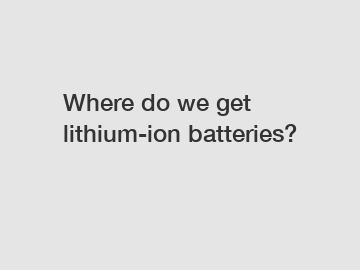Where do we get lithium-ion batteries?
In today's rapidly evolving technological landscape, lithium-ion batteries have emerged as one of the most critical components powering our gadgets, electric vehicles (EVs), and renewable energy systems. Their high energy density and long life-cycle make them indispensable for a wide range of applications. But where exactly do these lithium-ion batteries come from? Let's explore the journey of these remarkable powerhouses and uncover their sources.
Explaining Lithium-Ion Batteries:
Before diving into their origins, it's crucial to understand what lithium-ion batteries are. They consist of electrodes—an anode and a cathode—separated by an electrolyte, with lithium ions shuttling back and forth during charging and discharging cycles. This property sets them apart from traditional batteries, ensuring reliable and rechargeable power.

Sources of Lithium:
Lithium—the key element in lithium-ion batteries—is a metal increasingly in demand. The primary sources of lithium are found in three main categories: brine deposits, hard rock (pegmatite) deposits, and lithium-rich clay deposits.
Brine Deposits: .
Lithium-rich brine located beneath salt flats and saltwater lakes represents one of the largest sources of lithium. South America's "lithium triangle," comprising Argentina, Bolivia, and Chile, accounts for almost 60% of the world's lithium production. The brine is extracted through a process called evaporation, where large basins collect the brine, and solar evaporation aids in concentrating the lithium content.
Hard Rock (Pegmatite) Deposits:
An alternative source of lithium is through hard rock mining. Pegmatite, a type of igneous rock, contains minerals rich in lithium. Australia is a significant player in the hard rock mining industry, boasting some of the largest operating lithium mines worldwide. Mining involves crushing the rock and separating the lithium-bearing minerals for further processing.
Lithium-Rich Clay Deposits:
Another emerging source of lithium is lithium-rich clay deposits. These deposits are mostly located in regions like Nevada in the United States, where lithium is extracted from clay formations. Through a combination of selective mining and advanced processing techniques, the lithium content in the clay is separated, leading to the production of lithium compounds.
Battery Manufacturing Process:
Once lithium has been obtained and refined, battery manufacturers convert it into various chemical compounds necessary for the production of lithium-ion batteries. The most common compounds include lithium carbonate and lithium hydroxide. These compounds, combined with other materials such as graphite, nickel, cobalt, manganese, and aluminum, are used to create the battery's electrodes and electrolyte, each playing a crucial role in their functioning.
Global Supply Chain:
The production of lithium-ion batteries is a complex global process involving multiple countries. China, for instance, dominates the manufacturing industry and boasts a significant share of the lithium-ion battery market. Due to its abundance of rare earth minerals and governmental support, China has become a key player in the supply chain.
However, other countries are also making advancements in this field. Japan, South Korea, and the United States are actively investing in battery manufacturing facilities to strengthen their domestic supply chain and reduce reliance on imports.
Environmental Implications:
While lithium-ion batteries offer countless benefits, it is crucial to consider their environmental impacts. Mining lithium, particularly through hard rock extraction, can have consequences such as habitat destruction, water pollution, and carbon emissions. Mining companies are working towards implementing sustainable practices, but it remains a pressing concern that requires continuous improvement.
Conclusion:
Lithium-ion batteries have revolutionized the way we consume energy, powering our smartphones, laptops, EVs, and renewable energy systems. It is essential to understand that the journey of these batteries starts with the extraction of lithium from sources like brine deposits, hard rock, and lithium-rich clay deposits. Additionally, the global supply chain for lithium-ion batteries involves numerous countries, with China being the dominant player. As societal demands evolve, focusing on sustainable extraction practices becomes imperative to minimize the environmental impact of battery production.
By understanding the sources and supply chain of lithium-ion batteries, we can appreciate the significant effort and expertise required to bring these innovative power storage solutions to our everyday lives.
If you want to learn more, please visit our website electric storage forklift, heavy duty car battery, gc2 battery specs.

Comments
0